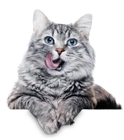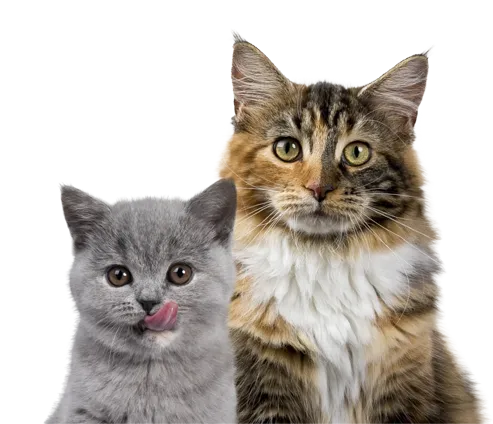
Understanding your cat’s microbiome can be tricky. After all, it’s a complex community of trillions of bacteria, but it plays a vital role in your cat’s overall health, making it worth our attention. This diverse microbiome is essential for digesting food, synthesizing nutrients, and supporting the immune system.
One of the most important factors in maintaining a healthy microbiome is diet, particularly the inclusion of fiber. Fiber promotes a healthy microbiome by feeding the “good” bacteria in the gastrointestinal tract. 1 In this article, we’ll explore how fiber, along with other key dietary considerations, can help support your cat’s digestive health and overall well-being by promoting a healthy microbiome.
What is a cat’s microbiome?
A cat’s microbiome is a collection of microorganisms (like bacteria and fungi) that live throughout the body in areas like the gut, skin, and mouth. These microorganisms work together to support key functions, including digestion, disease protection, and even skin and coat health. While a well-balanced microbiome can enhance your cat’s resilience and well-being, an unbalanced microbiome can lead to issues like digestive upset, immune weakness, and behavioral changes.
What’s the difference between a cat’s microbiome and a cat’s gut health?
There is a difference between gut health and microbiome, and it can be a little confusing. As mentioned, the gut microbiome is the population of microorganisms that inhabit the large intestine. This population is now thought of as an organ in its own right.
However, a cat’s gut health is the overall health of their digestive system, which is affected by their microbiome. A cat’s gut health is important for many aspects of their health, including digestion, nutrient absorption, and immune system regulation. But, today, we are getting into the details of your cat’s microbiome and how best to support it.
Signs of an unbalanced microbiome in cats
When a cat’s microbiome becomes unbalanced, it can manifest in several ways, including:
- Digestive issues: Symptoms like flatulence, diarrhea, or constipation are common indicators of an unhealthy microbiome.
- Excessive inflammation: Chronic inflammation can be a sign of a struggling gut microbiome.
- Weakened immune system: A poor microbiome can make your cat more susceptible to infections.
Addressing these symptoms involves nurturing a balanced microbiome through diet, supplements, and lifestyle practices.
Causes of gut health problems in cats
There are a variety of reasons why your cat might be suffering from microbiome issues, including:
- Dietary changes
- Antibiotics, or other medication
- Stress
- Infectious agents, such as bacteria picked up from other animals, or from when they are outdoors2
Of course, if you do notice anything concerning about your cat, always call the vet in the first instance.
How to support your cat’s microbiome
Provide a balanced diet
A balanced, high-quality diet is the foundation of a healthy microbiome. Cats are obligate carnivores, so they require a protein-rich diet to thrive. Look for cat foods with ‘complete and balanced” labels that include animal-based proteins, essential vitamins, and minerals.
Additionally, if you need to change your cat’s food for whatever reason, it’s important to introduce a new food gradually. Without a gradual transition, the microbiome doesn’t get the chance to adapt, and therefore, causes digestive upset.
If your cat suffers from allergies — avoid anonymous ingredients or category declarations. These recipes make it impossible to avoid ingredients that could be a trigger for your cat’s sensitivities.
Wet food can be especially beneficial for older cats, as it provides moisture that helps with hydration. You might find a wet food diet more suitable for your cat as their appetite reduces and their teeth weaken.
Fiber
Dietary fiber is an essential component of a cat’s diet that profoundly influences the gut microbiome. It provides a fermentable substrate for specific microbes, allowing them to thrive and carry out functions vital to gut health. By promoting the diversity, richness, and balance of microbial populations, fiber helps ensure a healthy microbiome.
Fiber isn’t just about feeding the gut’s microbial inhabitants — it also plays a mechanical role in your cat’s digestive system. Adequate fiber intake aids in maintaining healthy gut motility, helping food move efficiently through the digestive tract. This can prevent complications such as gut motility and reduce the likelihood of anal gland problems by supporting regular bowel movements.
The Role of Prebiotics and Fiber in the Gut
Certain fibers, termed prebiotics, selectively feed beneficial bacteria in the gut. These non-digestible plant fibers enhance the growth and activity of microbes that contribute positively to gut health, directly influencing microbiome composition and improving the host’s well-being. In addition to supporting bacterial populations, prebiotics can also contribute to smoother digestion and reduce the risk of gut motility issues.
Prebiotics, probiotics, and postbiotics
While fiber acts as a prebiotic, other microbiome-supporting tools include probiotics and postbiotics. Probiotics are live microorganisms, such as certain bacteria or yeast, that can be introduced into your cat’s diet to boost beneficial microbial populations. Postbiotics, on the other hand, are bioactive compounds produced by these microbes such as short-chain fatty acids that play a direct role in reducing inflammation and strengthening the gut lining.
When combined, a diet rich in fiber with appropriate probiotics and postbiotics creates a flow that not only supports a healthy microbiome but also helps protect against digestive and systemic issues. Many cat foods will already include probiotics, prebiotics, and postbiotics or you can supplement your cat if needed. As always, it’s best to speak to your vet when adding supplements.
Read more about probiotics here.
Avoid high-fat and protein
While cats are obligate carnivores and require protein in their diet, excessive amounts of fat and protein can lead to digestive issues, particularly for cats with sensitive stomachs. High-fat diets can strain digestion, while overly rich protein sources may disrupt the balance of the gut microbiome. Ensuring that your cat’s diet is balanced in macronutrients—without veering into extremes—helps maintain stable digestion and gut health.
Feeding the correct quantity
Even the healthiest food can cause problems if fed inappropriately. Overfeeding, regardless of food quality, can overwhelm your cat’s digestive system, leading to upset stomachs and imbalances in the microbiome. The correct quantity of food should be tailored to your cat’s size, lifestyle, and age. For example, active or younger cats may require more calories, while older or less active cats may need reduced portions to avoid overburdening their gut.
We uphold the highest editorial standards when creating the authoritative content pet parents rely on and trust.
Every piece of clinical content on the Cat Food Advisor is reviewed by our certified Veterinary Advisory Board, which consists of licensed veterinarians and medically certified specialists.
Our reviews are completely independent; we are not paid by any pet food company to promote their products favorably. We do not accept money, gifts, samples or other incentives in exchange for special consideration. For more information see our Disclaimer & Disclosure page.









